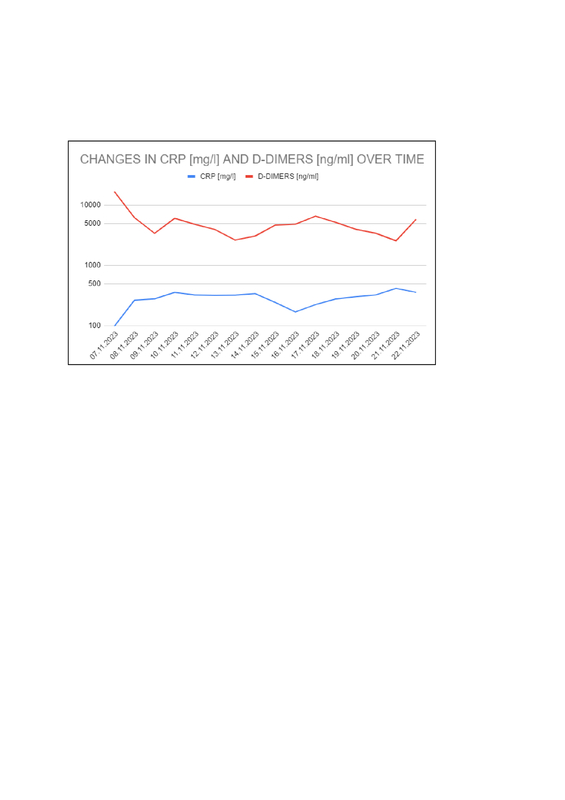CASE REPORT
Salmonella sepsis in a patient after infection of the aorto-biiliac stent graft implanted due to a ruptured aneurysm of the right common iliac artery – case report and literature review
1
Student Research Group/Second Department of Anaesthesiology and Intensive Therapy, Medical University, Lublin, Poland
2
Second Department of Anaesthesiology and Intensive Therapy, Medical University, Lublin, Poland
Corresponding author
Julia Siek
Student Research Group of The Second Department of Anaesthesiology and Intensive Therapy, Medical University, Staszica 16, 20-081 Lublin, Poland
Student Research Group of The Second Department of Anaesthesiology and Intensive Therapy, Medical University, Staszica 16, 20-081 Lublin, Poland
J Pre Clin Clin Res. 2024;18(3):190-194
KEYWORDS
TOPICS
ABSTRACT
Stent grafts are the most popular method of treating aneurysms. The incidence of vascular graft infection is 0.5% to 5%.
In turn, the incidence of infection after percutaneous insertion of intravascular stent grafts is much lower and reaches
approximately 1%, or less. The infection may be local, develop into acute sepsis, or develop into a chronic infection with
septic flares. Stent graft infection in peripheral arteries is rare and dangerous. A foreign body, such as a stent graft, usually
does not cause a reaction in body. However, cases of colonization with bacteria resulting in local or generalized infection
have been described. Two types of body reactions to graft can be distinguished: an acute inflammatory response leading
to the formation of an abscess, and a chronic inflammatory process with fibrosis. The case is presented of a patient with
sepsis lasting several weeks, the result of infection of the aorto-biiliac stent graft. A review of the literature on the subject
is also presented.
Siek J, Sysiak-Sławecka J. Salmonella sepsis in a patient after infection of the aorto-biiliac stent graft implanted due to a ruptured aneurysm of the right common iliac artery – case report and literature review. J Pre-Clin Clin Res. 2024; 18(3): 190–194. doi: 10.26444/jpccr/190745
REFERENCES (21)
1.
Bauer M, Gerlach H, Vogelmann T, Preissing F, Stiefel J, Adam D. Mortality in sepsis and septic shock in Europe, North America and Australia between 2009 and 2019 – results from a systematic review and meta-analysis. CritCare. 2020;19;24(1):239. doi:10.1186/s13054-020-02950-2.
2.
Global report on the epidemiology and burden of sepsis: current evidence, identifying gaps and future directions. Geneva: World Health Organization; 2020. Licence: CC BY-NC-SA 3.0 IGO.
4.
Rhee C, Dantes R, Epstein L, Murphy DJ, Seymour CW, Iwashyna TJ, et al. Incidence and trends of sepsis in US hospitals using clinical vs claims data, 2009–2014. JAMA. 2017;318:1241. doi:10.1001/jama.2017.13836.
5.
Löffler B, Tuchscherr L. Staphylococcus aureus Toxins: Promoter or Handicap during Infection? Toxins (Basel). 2021 Apr 19;13(4):287. doi:10.3390/toxins13040287.
6.
Linares-Palomino JP, Lopez-Espada C. Infectious Complications of EVAR are Deadlier than Those of Conventional Surgery. Eur J VascEndovascSurg. 2019 Jan;57(1):137. doi:10.1016/j.ejvs.2018.08.036.
7.
Salomão R, Ferreira BL, Salomão MC, Santos SS, Azevedo LCP, Brunialti MKC. Sepsis: evolving concepts and challenges. Braz J Med Biol Res. 2019;52(4):e8595. doi:10.1590/1414-431X20198595.
8.
Luhr R, Cao Y, Söderquist B, Cajander S. Trends in sepsis mortality over time in randomized sepsis trials: a systematic literature review and meta-analysis of mortality in the control arm, 2002–2016. CritCare. 2019;23:1.
9.
Huang M, Cai S, Su J. The Pathogenesis of Sepsis and Potential Therapeutic Targets. Int J Mol Sci. 2019 Oct 29;20(21):5376. doi:10.3390/ijms20215376.
10.
Gauer R, Forbes D, Boyer N. Sepsis: Diagnosis and Management. Am Fam Physician. 2020 Apr 1;101(7):409–418.
11.
Gupta S, Sakhuja A, Kumar G, et al. Culture-negative severe sepsis: nationwide trends and outcomes. Chest. 2016;150(6):1251–1259.
12.
Nannan Panday RS, Lammers EMJ, Alam N, et al. An overview of positive cultures and clinical outcomes in septic patients. CritCare. 2019;23(1):182.
13.
White HD, Vazquez-Sandoval A, Quiroga PF, et al. Utility of venous blood gases in severe sepsis and septic shock. Proc (BaylUnivMed Cent). 2018;31(3):269–275.
14.
Rhodes A, Evans LE, Alhazzani W, et al. Surviving Sepsis Campaign: international guidelines for management of sepsis and septic shock: 2016. CritCare Med. 2017;45(3):486–552.
15.
McIntyre L, Rowe BH, Walsh TS, et al.; Canadian Critical Care Trials Group. Multicountry survey of emergency and critical care medicine physicians’ fluid resuscitation practices for adult patients with early septic shock. BMJ Open. 2016;6(7):e010041.
16.
Sakr Y, Rubatto Birri PN, Kotfis K, et al.; Intensive Care Over Nations Investigators. Higher fluid balance increases the risk of death from sepsis: results from a large international audit. CritCare Med. 2017;45(3):386–394.
17.
Oczkowski S, Alshamsi F, Belley-Cote E, Centofanti JE, Moller MH, Nunnaly ME, Alhazzani W. Postępowanie w sepsie i wstrząsie septycznym. Praktyczne wskazówki z wytycznych SurvivingSepsisCampaign 2021. Med Prakt. 2022;10:31–42.
18.
Seymour CW, Kennedy JN, Wang S, et al. Derivation, validation, and potential treatment implications of novel clinical phenotypes for sepsis. JAMA. 2019;321(20):2003–2017.
19.
Miszczuk M, Rylski R, Hołody Ł, Tarnawska-Pierścińska M. Stent graft infection treated with dalbavancin in patient after endovascular repair of thoracic and abdominal aortic dissection-case report. Forum zakażeń. 2018;9(1);45–48. doi:dx.doi.org/10.15374/FZ2018013.
20.
Carrel T, Englberger L, Schmidli J. How to treat aortic graft infection? With a special emphasis on xeno-pericardial aortic tube grafts. Gen Thorac Cardiovasc Surg. 2019 Jan;67(1):44–52. doi:10.1007/s11748-017-0839-0.
21.
Li HL, Chan YC, Cheng SW. Current Evidence on Management of Aortic Stent-graft Infection: A Systematic Review and Meta-Analysis. Ann VascSurg. 2018 Aug;51:306–313. doi:10.1016/j.avsg.2018.02.038.
We process personal data collected when visiting the website. The function of obtaining information about users and their behavior is carried out by voluntarily entered information in forms and saving cookies in end devices. Data, including cookies, are used to provide services, improve the user experience and to analyze the traffic in accordance with the Privacy policy. Data are also collected and processed by Google Analytics tool (more).
You can change cookies settings in your browser. Restricted use of cookies in the browser configuration may affect some functionalities of the website.
You can change cookies settings in your browser. Restricted use of cookies in the browser configuration may affect some functionalities of the website.


